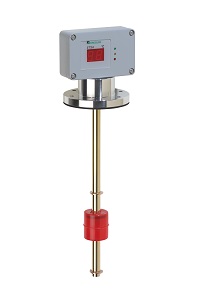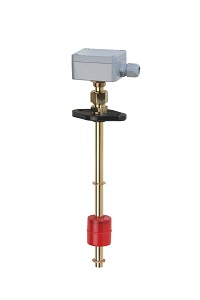A float switch with an electronic temperature switch/controller is a combined device that allows for both liquid level measurement using a float switch and temperature control using an electronic temperature switch/controller. It is particularly useful in applications where both the liquid level and temperature of a fluid tank or container need to be monitored and controlled.
Operation Principle
The operating principle of a float switch based on a Reed contact relies on the use of a Reed contact as a switching element. A float switch consists of a buoyant body, also known as a float, which floats on the liquid surface. The buoyant body is equipped with a magnet. When the liquid level changes, the buoyant body moves up or down accordingly. When it reaches a certain fill level, the magnet approaches the Reed contact. The Reed contact consists of two ferromagnetic contact leaves placed inside a glass bulb. These leaves are separated by a small air gap. When the magnet of the buoyant body reaches the Reed contact, the magnetic field attracts the ferromagnetic leaves and brings them together. This action closes the contact leaves, completing an electrical circuit. This closed circuit can be used to send a signal, such as triggering an alarm or controlling a motor.
The electronic temperature switch/controller monitors the temperature of the liquid in the container. For this purpose, a temperature sensor is used to measure the current temperature of the liquid and convert it into an electrical signal. The signal is then relayed to a microcontroller or electronic control unit. The microcontroller processes the temperature signal and compares it to a predefined setpoint. Depending on whether the measured temperature reaches, falls below, or exceeds the setpoint, the microcontroller controls the corresponding output components. These components can include heating elements or cooling devices that are activated or deactivated to regulate the temperature within the container.
Advantages
- Cost Efficiency: A combined device combines the functions of two separate devices into one, reducing acquisition costs and saving space.
- Space Savings: Integrating level measurement and temperature control in one device requires less installation space, which is particularly advantageous in confined environments.
- Easy Installation: A single device is easier to install than two separate devices, as it requires less wiring and attachments.
- Holistic Process Control: Combining level measurement and temperature control enables comprehensive and holistic control of processes where both level and temperature are critical parameters.
- Enhanced Process Safety: Simultaneously monitoring level and temperature helps detect and prevent potential issues such as overfilling, running dry, or inadequate cooling.
- Improved Product Quality: Precise temperature control ensures consistent product quality, especially in sensitive industries such as food and pharmaceutical applications.
- More Efficient Energy Use: Precise temperature regulation allows for optimal use of heating and cooling energy, leading to reduced energy consumption.
- Reduced Downtime: Combining level measurement and temperature control enables early detection of problems, minimizing equipment failures and unplanned downtime.
- Flexibility and Adaptability: A combined device can be used for various applications and processes, enhancing the flexibility of automation systems.
- User-Friendly: Combining both functions in one device simplifies operation and maintenance, as only one device needs to be configured and maintained.
Industries and Applications
Liquid Tanks in Manufacturing Facilities
- The float switch monitors the liquid level in tanks to prevent overflows or inadequate fluid supply.
- The electronic temperature switch/controller ensures that the liquid in the tank remains within a specific temperature range to maintain optimal operating temperature.
Cooling of Industrial Machinery
- The float switch controls the water level in cooling tanks of machinery to ensure sufficient cooling.
- The electronic temperature switch/controller regulates cooling to keep the temperature of industrial machinery or processes within predefined limits.
Lubrication Systems
- The float switch monitors oil levels in lubricating oil tanks, preventing damage to machinery due to oil deficiency.
- The electronic temperature switch/controller monitors oil temperature and ensures optimal lubricating oil temperature for efficient lubrication.
Heating Systems
- The float switch regulates the water level in heating systems to ensure safe operation and adequate water supply.
- The electronic temperature switch/controller controls heating power to achieve and maintain the desired room temperature or process temperature.
Steam Boilers and Steam Generators
- The float switch monitors the water level in steam boilers, preventing them from drying out or overflowing.
- The electronic temperature switch/controller monitors steam temperature to ensure safe and efficient steam generation.



